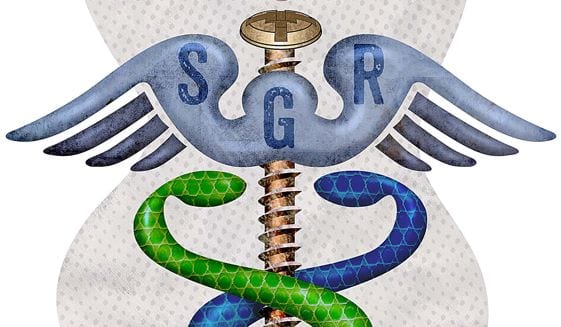It’s that time of year again. Absent Congressional action, physicians will see a 21% cut in Medicare Physician Fee Schedule payments April 1. That’s no April Fools’ Day prank: the most recent short-term sustainable growth rate (SGR) fix expires March 31.
The Congressional Budget Office estimates the cost of repealing the SGR at $174 billion. Not surprisingly, most observers expected Congress to opt for yet another (the 18th, in fact) short-term patch, most likely paid for (again) by reducing hospital payments and extending the 2% sequestration cut to Medicare payments.
However, on March 19, Congressional leaders introduced H.R. 4017 and S. 810, The SGR Repeal and Medicare Provider Payment Modernization Act. This bi-partisan legislation was crafted last year as a permanent solution to the SGR problem.
The following is a brief summary of that legislation, which also replaces current Medicare value-based purchasing programs with a single Merit-Based Incentive Payment System, or MIPS.
The Basics
- The SGR formula now used to calculate MPFS rates is repealed effective April 1, 2015, avoiding the scheduled 21% reduction in those payments.
- Current MPFS rates will be increased by 0.5% effective June 1, and each year thereafter through 2019.
- MPFS rates will remain constant at the 2019 rates through 2025.
- During that same period – 2019 to 2025 – providers will have the opportunity to earn bonus payments available through the new Merit-Based Incentive Payment System, or MIPS, discussed in greater detail below.
- After December 31, 2018, providers no longer will be subject to the penalties associated with the Physician Quality Reporting System (PQRS), the meaningful use program, or the physician value-based purchasing program; these programs will be replaced with MIPS. Current Medicare value-based purchasing programs for hospitals will remain in place.
- Beginning in 2026, and thereafter, the MPFS rates will be updated annually by 0.5%. However, providers who participate in approved alternative payment models (as discussed below) will receive an additional 0.5% increase, earning a total annual increase of 1.0%.
Merit-Based Incentive Payment System
So let’s talk MIPS. This new version of physician value-based purchasing starting in 2019 will be based on a provider’s score in four areas: quality measures; efficiency measures; meaningful use of electronic health records; and clinical practice improvement activities. While the legislation provides parameters for each category, the detail work is left to the Centers for Medicare & Medicaid Services (CMS).
Providers will receive a composite performance score from 1 to 100 based on their performance on the to-be-specifically-defined measures. Providers whose scores improve year-to-year will receive extra credit, as a way to incentivize performance improvement.
Each year, CMS will establish a threshold score based on the median or mean composite performance scores of all providers measured during the previous performance period. The threshold will be published at the beginning of each year, in advance of the performance period to be measured.
Providers scoring below the threshold will be subject to payment reductions. These negative payment adjustments will be capped at 4% in 2019, 5% in 2020, 7% in 2021, and 9% in 2022.
Over time, the MIPS penalties become substantially greater than those contemplated in existing CMS programs. This, coupled with the fact private payers are likely to “piggy-back” on the MIPS program, make the push for quality and efficiency simply too strong for providers to ignore.
Providers scoring above the threshold will receive MIPS bonus payments. Those providers with higher performance scores will receive proportionately larger payments, up to three times the annual penalty cap. These payments will be funded by the penalties assessed against providers scoring below the threshold.
In addition, the best-of-the-best – those who score above a “stretch” performance score established by CMS – will receive an additional bonus payment allocated from a $500 million annual pool. These additional incentive payments will be allocated according to a linear distribution, with better performers receiving larger bonuses.
Providers who receive a significant percentage of their income through alternative payment mechanisms (APMs) that involve risk of financial losses and quality reporting requirements will have the option to opt out of MIPS, and instead receive an annual 5% bonus payment between 2019 and 2024. Again, the legislation provides broad outlines, leaving it to CMS to define exactly what qualifies as an APM and what amounts to a significant percentage of income.
The proposed legislation specifically provides that any standard established under any federal healthcare program cannot be used in a medical malpractice case as evidence of a standard or duty-of-care owed by a provider to a patient. Thus, MIPS participation cannot be used in liability cases.
Other Provisions
- Provides funding for quality measures development and technical assistance for smaller physician practices
- Expands access to Medicare claims data to support quality improvement activities
- Expands the information made publicly available regarding individual physician scores on performance measures
- Requires that Electronic Health Records (EHR) be interoperable by 2018 and prohibits providers from deliberately blocking information sharing with other EHR vendor products.
- Requires the Secretary to issue a report recommending how a permanent physician-hospital gainsharing program can best be established.
- Requires GAO to report on barriers to expanded use of telemedicine and remote patient monitoring.
Funding
Presently, Congressional leaders are discussing the SGR fix as part of a package deal that includes an extension of the Children’s Health Insurance Program (CHIP), as well as funding for other specific Medicare programs. The package would be paid for through a combination of means testing, i.e., making wealthier individuals pay more for Medicare; changes to the Medigap program; and reductions in the payment updates for hospitals and post-acute providers.
These reforms will not cover the full price tag of the deal under consideration, but leaders will try to convince conservative critics that it will yield greater out-year savings after 10 years. As is usually the case in Washington, we’ll know what will happen when it happens.


